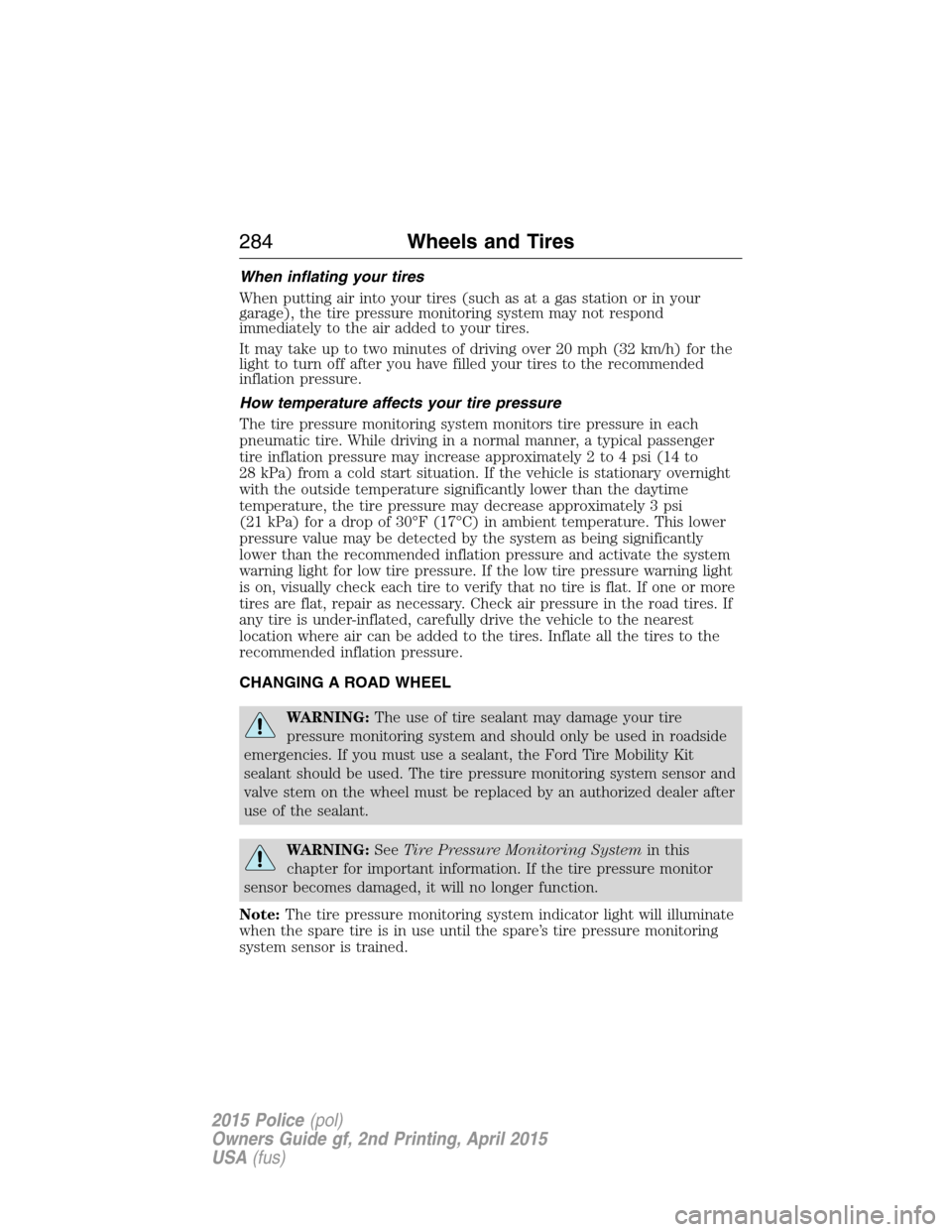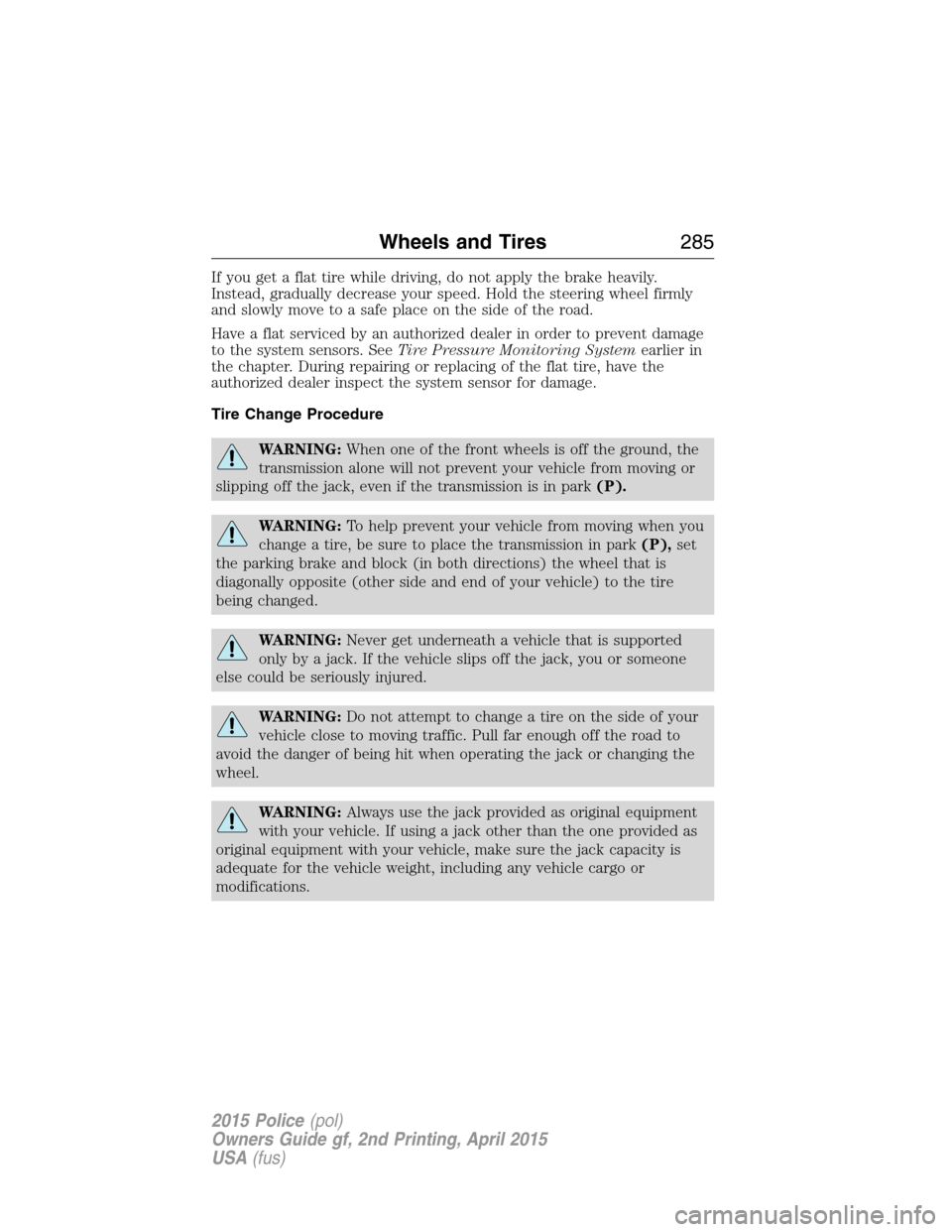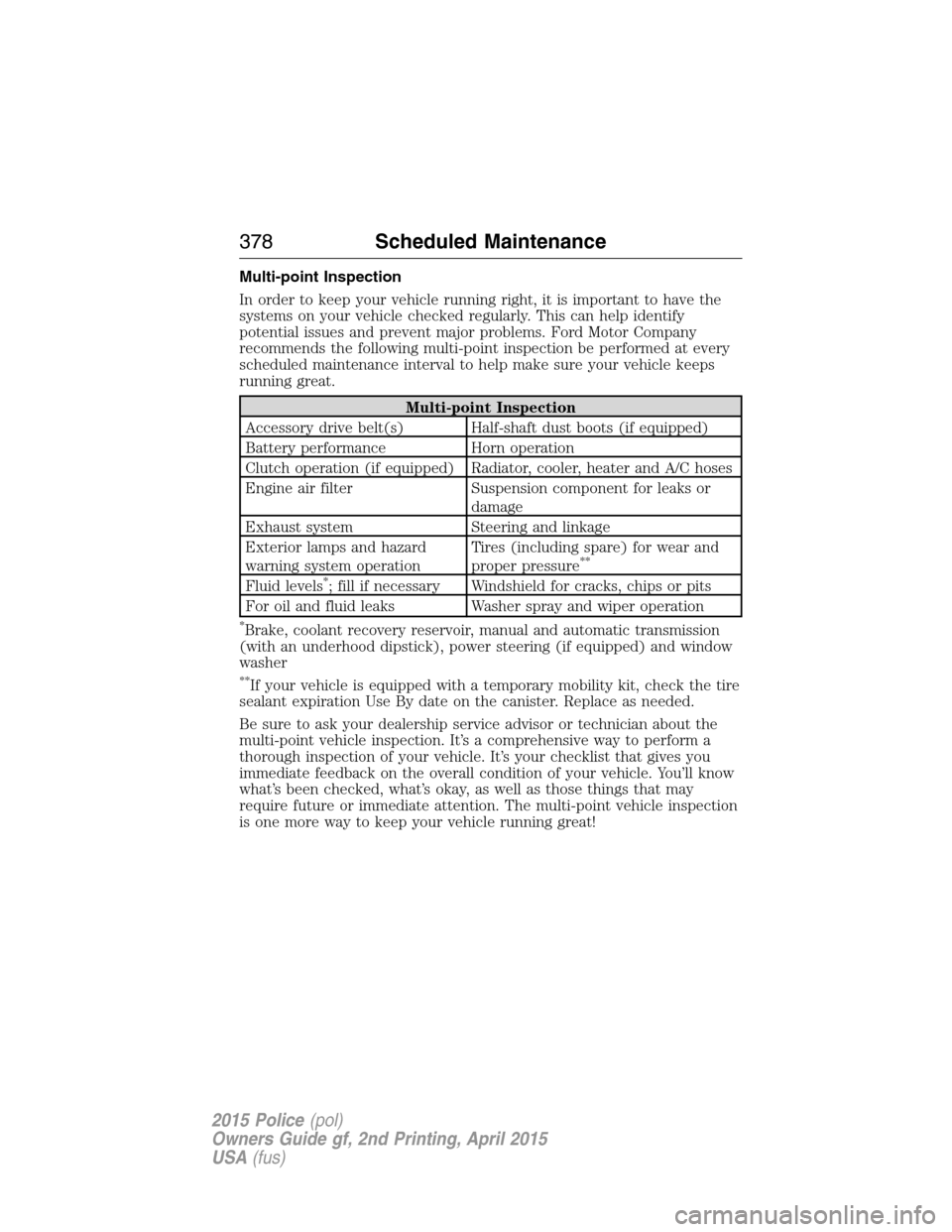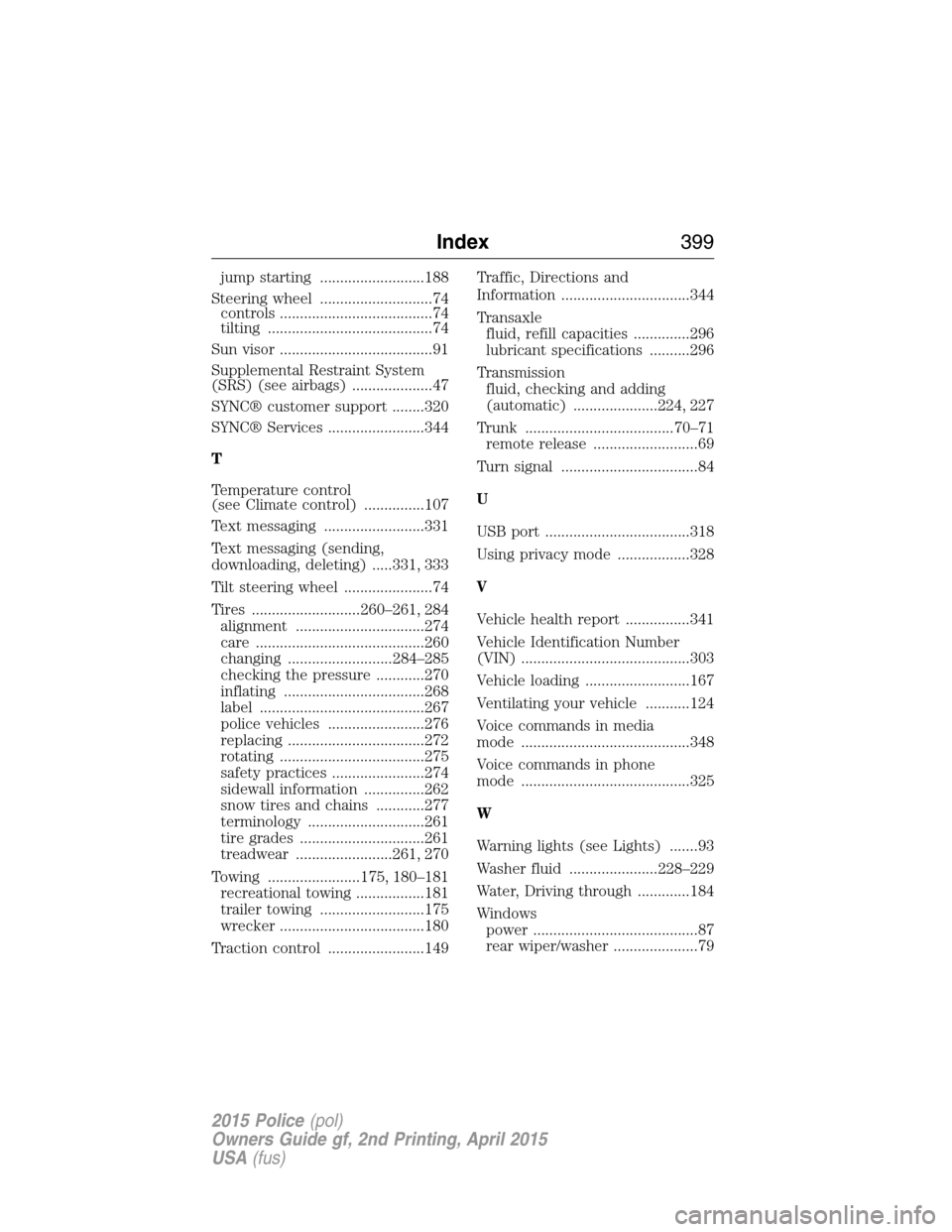2015 FORD POLICE INTERCEPTOR SEDAN tire pressure
[x] Cancel search: tire pressurePage 283 of 401

Training procedure
Note:It may take up to six seconds to activate a tire pressure sensor.
During this time, the tool must remain in place at the valve stem.
1. Place the tool on the LF tire sidewall at the valve stem. Press and
release the test button on the tool. The horn will sound briefly to
indicate that the tire pressure sensor has been recognized by the
on-board module.
2. Within two minutes of the horn sounding, place the tool on the RF tire
sidewall of the valve stem and press and release the test button to train
the RF tire pressure sensor.
Note:Do not wait more than two
minutes between training each
sensor or the module will time out
and the entire procedure must be
repeated.
3. Repeat Step 2 for the RR and LR tires. The procedure is completed
after the last tire has been trained. When the training procedure is
complete, the information display (if equipped) will show TIRE
TRAINING COMPLETE. For vehicles not equipped with an information
display , successful completion of the training procedure will be verified
by turning the ignition switch to the off position without the horn
sounding. If the horn sounds twice when the switch is turned to the off
position, the training procedure was not successful.
21
43
282Wheels and Tires
2015 Police(pol)
Owners Guide gf, 2nd Printing, April 2015
USA(fus)
Page 284 of 401

When you believe your system is not operating properly
The main function of the tire pressure monitoring system is to warn you
when your tires need air. It can also warn you in the event the system is
no longer capable of functioning as intended. See the following chart for
information concerning your tire pressure monitoring system:
Low tire
pressure
warning lightPossible cause Customer action required
Solid warning
lightTire(s)
under-inflated1. Make sure tires are at the proper
pressure. SeeInflating your tires
in this chapter.
2. After inflating your tires to the
manufacturer’s recommended
pressure as shown on the Tire
Label (located on the edge of
driver’s door or the B-Pillar), the
vehicle must be driven for at least
two minutes over 20 mph
(32 km/h) before the light turns
off.
Wheel and tire
swap without
trainingTrain the sensors to the vehicle.
See the TPMSTraining procedure
in this section.
TPMS
malfunctionIf the tires are properly inflated
and installed and trained, and the
light remains on, contact your
authorized dealer as soon as
possible.
Flashing
warning lightWheel and tire
swap without
trainingTrain the sensors to the vehicle.
See the TPMSTraining procedure
in this section.
TPMS
malfunctionIf the tires are properly inflated,
but the light remains on, contact
your authorized dealer as soon as
possible.
Wheels and Tires283
2015 Police(pol)
Owners Guide gf, 2nd Printing, April 2015
USA(fus)
Page 285 of 401

When inflating your tires
When putting air into your tires (such as at a gas station or in your
garage), the tire pressure monitoring system may not respond
immediately to the air added to your tires.
It may take up to two minutes of driving over 20 mph (32 km/h) for the
light to turn off after you have filled your tires to the recommended
inflation pressure.
How temperature affects your tire pressure
The tire pressure monitoring system monitors tire pressure in each
pneumatic tire. While driving in a normal manner, a typical passenger
tire inflation pressure may increase approximately 2 to 4 psi (14 to
28 kPa) from a cold start situation. If the vehicle is stationary overnight
with the outside temperature significantly lower than the daytime
temperature, the tire pressure may decrease approximately 3 psi
(21 kPa) for a drop of 30°F (17°C) in ambient temperature. This lower
pressure value may be detected by the system as being significantly
lower than the recommended inflation pressure and activate the system
warning light for low tire pressure. If the low tire pressure warning light
is on, visually check each tire to verify that no tire is flat. If one or more
tires are flat, repair as necessary. Check air pressure in the road tires. If
any tire is under-inflated, carefully drive the vehicle to the nearest
location where air can be added to the tires. Inflate all the tires to the
recommended inflation pressure.
CHANGING A ROAD WHEEL
WARNING:The use of tire sealant may damage your tire
pressure monitoring system and should only be used in roadside
emergencies. If you must use a sealant, the Ford Tire Mobility Kit
sealant should be used. The tire pressure monitoring system sensor and
valve stem on the wheel must be replaced by an authorized dealer after
use of the sealant.
WARNING:SeeTire Pressure Monitoring Systemin this
chapter for important information. If the tire pressure monitor
sensor becomes damaged, it will no longer function.
Note:The tire pressure monitoring system indicator light will illuminate
when the spare tire is in use until the spare’s tire pressure monitoring
system sensor is trained.
284Wheels and Tires
2015 Police(pol)
Owners Guide gf, 2nd Printing, April 2015
USA(fus)
Page 286 of 401

If you get a flat tire while driving, do not apply the brake heavily.
Instead, gradually decrease your speed. Hold the steering wheel firmly
and slowly move to a safe place on the side of the road.
Have a flat serviced by an authorized dealer in order to prevent damage
to the system sensors. SeeTire Pressure Monitoring Systemearlier in
the chapter. During repairing or replacing of the flat tire, have the
authorized dealer inspect the system sensor for damage.
Tire Change Procedure
WARNING:When one of the front wheels is off the ground, the
transmission alone will not prevent your vehicle from moving or
slipping off the jack, even if the transmission is in park(P).
WARNING:To help prevent your vehicle from moving when you
change a tire, be sure to place the transmission in park(P),set
the parking brake and block (in both directions) the wheel that is
diagonally opposite (other side and end of your vehicle) to the tire
being changed.
WARNING:Never get underneath a vehicle that is supported
only by a jack. If the vehicle slips off the jack, you or someone
else could be seriously injured.
WARNING:Do not attempt to change a tire on the side of your
vehicle close to moving traffic. Pull far enough off the road to
avoid the danger of being hit when operating the jack or changing the
wheel.
WARNING:Always use the jack provided as original equipment
with your vehicle. If using a jack other than the one provided as
original equipment with your vehicle, make sure the jack capacity is
adequate for the vehicle weight, including any vehicle cargo or
modifications.
Wheels and Tires285
2015 Police(pol)
Owners Guide gf, 2nd Printing, April 2015
USA(fus)
Page 378 of 401

Oils, Fluids and Flushing
In many cases, fluid discoloration is a normal operating characteristic
and, by itself, does not necessarily indicate a concern or that the fluid
needs to be changed. However, discolored fluids that also show signs of
overheating and foreign material contamination should be inspected
immediately by a qualified expert, such as the factory-trained technicians
at your dealership. Your vehicle’s oils and fluids should be changed at the
specified intervals or in conjunction with a repair. Flushing is a viable
way to change fluid for many vehicle sub-systems during scheduled
maintenance. It is critical that systems are flushed only with new fluid
that is the same as that required to fill and operate the system, or using
a Ford-approved flushing chemical.
Owner Checks and Services
Certain basic maintenance checks and inspections should be performed
every month or at six month intervals.
Check every month
Engine oil level.
Function of all interior and exterior lights.
Tires (including spare) for wear and proper pressure.
Windshield washer fluid level.
Check every six months
Battery connections. Clean if necessary.
Body and door drain holes for obstructions. Clean if necessary.
Cooling system fluid level and coolant strength.
Door weatherstrips for wear. Lubricate if necessary.
Hinges, latches and outside locks for proper operation. Lubricate if
necessary.
Parking brake for proper operation.
Safety belts and seat latches for wear and function.
Safety warning lamps (brake, ABS, airbag, safety belt) for operation.
Washer spray and wiper operation. Clean or replace blades as
necessary.
Scheduled Maintenance377
2015 Police(pol)
Owners Guide gf, 2nd Printing, April 2015
USA(fus)
Page 379 of 401

Multi-point Inspection
In order to keep your vehicle running right, it is important to have the
systems on your vehicle checked regularly. This can help identify
potential issues and prevent major problems. Ford Motor Company
recommends the following multi-point inspection be performed at every
scheduled maintenance interval to help make sure your vehicle keeps
running great.
Multi-point Inspection
Accessory drive belt(s) Half-shaft dust boots (if equipped)
Battery performance Horn operation
Clutch operation (if equipped) Radiator, cooler, heater and A/C hoses
Engine air filter Suspension component for leaks or
damage
Exhaust system Steering and linkage
Exterior lamps and hazard
warning system operationTires (including spare) for wear and
proper pressure
**
Fluid levels*; fill if necessary Windshield for cracks, chips or pits
For oil and fluid leaks Washer spray and wiper operation
*Brake, coolant recovery reservoir, manual and automatic transmission
(with an underhood dipstick), power steering (if equipped) and window
washer
**If your vehicle is equipped with a temporary mobility kit, check the tire
sealant expiration Use By date on the canister. Replace as needed.
Be sure to ask your dealership service advisor or technician about the
multi-point vehicle inspection. It’s a comprehensive way to perform a
thorough inspection of your vehicle. It’s your checklist that gives you
immediate feedback on the overall condition of your vehicle. You’ll know
what’s been checked, what’s okay, as well as those things that may
require future or immediate attention. The multi-point vehicle inspection
is one more way to keep your vehicle running great!
378Scheduled Maintenance
2015 Police(pol)
Owners Guide gf, 2nd Printing, April 2015
USA(fus)
Page 400 of 401

jump starting ..........................188
Steering wheel ............................74
controls ......................................74
tilting .........................................74
Sun visor ......................................91
Supplemental Restraint System
(SRS) (see airbags) ....................47
SYNC® customer support ........320
SYNC® Services ........................344
T
Temperature control
(see Climate control) ...............107
Text messaging .........................331
Text messaging (sending,
downloading, deleting) .....331, 333
Tilt steering wheel ......................74
Tires ...........................260–261, 284
alignment ................................274
care ..........................................260
changing ..........................284–285
checking the pressure ............270
inflating ...................................268
label .........................................267
police vehicles ........................276
replacing ..................................272
rotating ....................................275
safety practices .......................274
sidewall information ...............262
snow tires and chains ............277
terminology .............................261
tire grades ...............................261
treadwear ........................261, 270
Towing .......................175, 180–181
recreational towing .................181
trailer towing ..........................175
wrecker ....................................180
Traction control ........................149Traffic, Directions and
Information ................................344
Transaxle
fluid, refill capacities ..............296
lubricant specifications ..........296
Transmission
fluid, checking and adding
(automatic) .....................224, 227
Trunk .....................................70–71
remote release ..........................69
Turn signal ..................................84
U
USB port ....................................318
Using privacy mode ..................328
V
Vehicle health report ................341
Vehicle Identification Number
(VIN) ..........................................303
Vehicle loading ..........................167
Ventilating your vehicle ...........124
Voice commands in media
mode ..........................................348
Voice commands in phone
mode ..........................................325
W
Warning lights (see Lights) .......93
Washer fluid ......................228–229
Water, Driving through .............184
Windows
power .........................................87
rear wiper/washer .....................79
Index399
2015 Police(pol)
Owners Guide gf, 2nd Printing, April 2015
USA(fus)